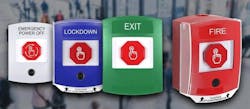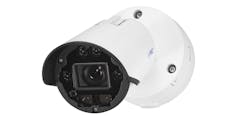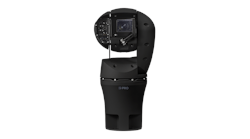Powering Up Security Devices
Many types of power supplies are available to the security industry because the requirements for each type and size of project present a different set of requirements. But as far as the actual creation of power, there are two basic power supply designs: linear and switching.
Some installation instructions for keypads and other electronic devices may clearly specify that the device may be used with one or the other type power supply. The instructions may state that using a switching mode power supply is not recommended, or the device might state a warning that the input voltage to the equipment must be within a certain percentage of the level specified. For a 24VDC device, that means the voltage must remain between 21.6 and 26.4 volts.
When you are dealing with long wire runs; multiple devices; marginal line voltage power quality and fluctuating loads, keeping your voltage within spec can be challenging, and disregarding the manufacturer’s specifications can result in unexpected consequences.
Security electronics typically operate on low voltage. Security equipment requires AC (Alternating Current) or DC (Direct Current).
AC requires the use of either a transformer which steps down line voltage (110-120VAC) from the receptacle to usually 12 or 24 Volts Alternating Current (12VAC or 24VAC).
DC requires a power supply which typically performs the step down from line voltage, then does the additional steps required to produce an adequate quality Direct Current.
The first question that tech support will ask is: “What is the voltage reading at the input of the equipment?” Make that measurement before you make that phone call. You might be surprised.
Linear and switching mode power supplies each have their own characteristics which you should keep in mind so that you can make an informed choice for future products.
Linear power supplies work by first lowering line voltage to a lower value (e.g. 12VAC) using a transformer. This lower voltage is still AC. Then rectification is done by a set of diodes transforming this AC voltage into pulsating voltage. The next step is filtering by an electrolytic capacitor.
The DC obtained after the capacitor contains ripple. Ripple is a small amount of AC voltage which rides on the DC voltage. Unregulated linear power supplies have ripple which is not critical for many applications. Excessive ripple is manifested as hum bars in video equipment, and a low frequency audible noise on audio based equipment.
For applications where the amount of ripple is an issue, or a steady voltage output is important, a regulated power supply is required. This is done by installing a zener diode or a voltage regulator integrated circuit.
The size of the transformer and the capacitance (and thus the size) of the electrolytic capacitor are inversely proportional to the frequency of the input AC voltage. The lower the AC voltage frequency, the bigger the size of those components and vice-versa.
Since linear power supplies use the low frequency 60 Hz, the transformer and the capacitor are very big. The higher the current rating of the linear power supply, the larger its transformer will be. You can tell the power rating of a linear power supply by how much it weighs.
By comparison, switching mode power supplies (SMPS) offer different features, and advantages over linear versions. SMPS technology tends to be smaller that the corresponding linear model and their output remains constant. Very frequently a linear power supply’s output will fluctuate with the line voltage level, and also the output voltage may fluctuate with the load. For example, an electric locking device may draw an inrush current when power is first applied, and the lock actuates, while the holding current will be substantially lower.
Because much state-of-the art security electronics have very specific voltage requirements, and electric locks may cause fluctuations of voltage level with linear power supplies, SMPS (switching mode power supplies) are growing in use in security.
On high-frequency switching power supplies, the input voltage’s frequency is increased before going into the transformer, allowing the transformer and the electrolytic capacitor to be very small. This means a SMPS uses less copper, and it costs less to ship them to us from China.
Here is how simple switching mode power supply works.
1. The AC power-line voltage enters the power supply, and is rectified and filtered to DC.
2. The DC is “chopped” into pulses (converted to high-frequency AC) by transistor switches.
3. The ultrasonic AC goes through a lightweight isolation transformer.
4. The transformer output is rectified and filtered to the correct DC voltage for the amplifier.
5. The output voltage is then fed to the power-amp circuits. The switches dissipate very little power when they are on or off, which results in high efficiency, eg smaller size and less heat.
Switching power supplies typically have higher voltages present, typically half of the line voltage being supplied. This means a more dangerous environment inside the power supply enclosure.
Another issue is the high frequencies associated with SMPS. Some security electronics are sensitive to these high frequencies.
Finally, switching mode power supplies have a reputation for producing huge transient spikes on their outputs in the course of failing in service. This results in damage to other hardware in addition to the interruption of operation of the system to which it is connected. Linear power supplies fail too, only they do not usually shoot surges out into other gear.
Which power supply design is best? There is a time and place for both types.
HONEYWELL HPFF8
The new Honeywell Power Products HPFF8 (FireForce 8) power supply is designed to provide installers substantial time-saving benefits when expanding fire alarm NACs (notification appliance circuits) and provide auxiliary power to 24-volt system accessories. HPFF8 supplies can be activated by any 12- or 24-Volt fire alarm control panel or operate alone. The HPFF8 also offers an exclusive EOL (end-of-line) resistor replacement and NAC trouble memory features.
One of the most challenging aspects of a retrofit application is locating the existing EOL resistor.
The HPFF8’s EOL resistor replacement feature is designed to save security technicians hours of searching for the pre-existing EOL resistor. In retrofit applications, a single resistor matching the existing EOL can be used as a reference EOL for all outputs. This feature speeds installation and system checkout.
Frequently, NAC trouble alarms clear themselves prior to a maintenance call. Feedback collected through Honeywell Power Products’ Voice of the Customer process indicated a need for fire alarm technicians to identify the source of NAC troubles on-site. The HPFF8 includes a trouble memory feature that displays past troubles (by NAC) for rapid installer diagnostics. This feature allows technicians to investigate the source of recurring troubles and prevent future false alarms.
Available in 8-amp, it provides regulated and filtered 24 VDC power, each of 4 NAC’s are rated at 3.0 Amp with aux power rated 1.5 Amp.
The outputs may be configured as: four Class B (Style W, X, Y); or two Class A (Style Z); or two Class B and one Class A; or four Class A (Style Z) with the optional Class A adaptor installed.
They also contain a battery charger capable of charging up to 26 Amp Hour batteries.
The HPFF8 provides independent output circuit supervision. Therefore, in the event of a NAC fault, the power supply can notify the attached fire alarm control panel.These supplies are commonly used for NAC device synchronization to meet ADA (Americans with Disabilities Act) requirements.
The HPFF8 features field-selectable, built-in strobe and horn synchronization protocols, and a pass-through feature that allows a pre-generated sync protocol to pass from another synchronization source.
The independent horn silencing feature allows synchronized horns and strobes that operate on a single circuit to have the horns silenced via sync protocol.
For enhanced notification appliance circuit survivability, dual-activation inputs can be utilized for redundant trip operation.
Information: www.honeywellpower.com. or phone 877-477-7697.
RCI 10-5 Power Supply
RCI’s filtered and regulated 10 Series DC Power Supplies incorporates many life safety options including fire panel interface, instant unlock upon power failure and remote override reset capabilities for authorized personnel.
The 10-5 will accept an input of 90 - 250VAC, remaining stable during fluctuations in local power such as brown-outs.
The RCI 10-5 output is Field Selectable 12VDC@5A or 24VDC@3A output.
AC Fail Monitoring Relay can be used to send a signal to an external monitoring panel or guard station to indicate that the AC power to the panel has been interrupted. It can also be used to signal fire panel distribution board of AC fail to meet NFPA-101 Life Safety standards.
Battery Monitoring Relay can be used to send a signal to an external monitoring panel or guard station to indicate that the backup battery is not connected or is no longer holding a charge.
The RCI 10-5 Power Supply has cULus Listed Subassembly Modular Output Boards available, meaning that the zone output and fire disconnect boards can be added or removed from the 10-5 as required without affecting the cULus listing.
Each output can be selectively configured to turn ON, OFF or remain unchanged when the fire alarm control panel triggers the board, allowing the installer to power multiple devices with the same power supply. EOL Fire Panel Supervision
When more than one 10-5 PDD-FT is used within a building, a common circuit complete with EOL can be run from unit to unit and then to the fire panel. This will ensure that all power supplies are monitored and drop out during a fire as required by code.
Input
AC input 90VAC to 250VAC @ 60Hz or 50Hz
Automatic input sensing
AC visual indicator
Output
Nominal Output Voltage 12VDC or 24VDC
Typical Output Voltage 12VDC nominal, 10.4-13.7VDC, 5A. 24VDC nominal, 22.7-25.2VDC, 3A Note: Typical voltage measured without load.
5 Amps supply current at 12VDC
3 Amps supply current at 24VDC
Class II Power limited thermally protected DC output
LED visual indicator for AC & DC
Battery Backup
Fully integrated charging circuit
Automatic resetting battery over current protection
Reverse hookup protection .9A PTC
Average recharge current 735ma
LED visual indicator
Supervision
Form “C” AC fail relay rated for 2A @ 110VAC
Form “C” battery trouble relay rated for 2A @ 110VAC
Internal battery cut-off relay to protect batteries from deep discharge 9.8VDC & 19.6VDC
Enclosure tamper switch for connection to a UL approved burglary panel when used in UL 603 applications
Environmental
For indoor use only
Operating temperature -0°C to 49°C - (32°F to 120°F)
RCI 10-5 option modules include:
PDD-FT Board fire panel control interface.
PDD-8PCI Board power distribution/control interface.
PDM-4, PDM-4C, PDM-8 and PDM-8C Boards distribute a single low voltage AC or DC source into 4 or 8 outputs.
Information: www.rutherfordcontrols.com.
ALTRONIX ALTV244UL SERIES
These power supplies are primarily designed for video surveillance with individually protected outputs and the ability to step up the output from the nominal 24VAC up to 28VAC for long cable runs to cameras, but they can also be used wherever you need 3.5 Amps (85VA) of power supply. For example you could use this to provide separate power to a door locking device and an access control, (such as a timer module or keypad) to provide more reliable operation but still only involving a single power supply enclosure.
All models have a primary in-line fuse. Different models offer fuses or PTCs on the distributed outputs. The separate power distribution board is switched and have large screw barrier terminal strips for added installer convenience during setup and troubleshooting.
Features include:
UL Listed for Commercial CCTV Equipment (UL 2044).
CUL Listed - CSA Standard C22.2 No.1-98, Audio, Video and Similar Equipment.
Surge suppression.
AC power LED indicator.
Power ON/OFF switch (ALTV244UL, ALTV244ULX or ALTV244ULCB).
Illuminated power disconnect circuit breaker with manual reset (ALTV244175UL, ALTV244175ULCB).
Unit maintains camera synchronization.
Ease of installation saves time & eliminates costly labor.
Spare fuses included (on fuse protected models).
Enclosure dimensions for models ALTV244UL and ALTV244ULCB are 8.5 inches high by 7.5 inches wide by 3.5 inches deep. ALTV244ULX dimensions are 13 inches high by 13.5” wide by 3.25 inches deep. Models ALTV244175UL and ALTV24175ULCB are 12.25 inches high by 7.75 inches wide by 4.5 inches deep.
Information: www.altronix.com.
SECURITRON BPS
Securitron manufactures a variety of products designed to supply and monitor 12 or 24 volts for the operation of security and safety equipment. The Boxed Power Series (BPS) power supplies are designed for applications requiring an interface with a fire alarm system or battery backup. The BPS Series linear power supplies are UL Class 2 listed, allowing for wire runs without the use of conduit from power supply to door.
Features include:
1, 4 or 8 separate output circuit breakers based on model
LEDs monitor zone status (voltage, no voltage)
Slide switches connect or disconnect load from power (excludes 1 Amp)
Internal capability of charging option 12 or 24VDC sealed lead acid backup batteries while operating the DC load (battery not included)
Complete - Requires only 110VAC to the fused input (BPS)
Rugged steel enclosure
Provided with terminals for fire alarm relay connection, allowing release of all devices upon fire alarm activation
Clean linear power for flawless operation with all sensitive active electronic components
BPS UL Listed
Operating Temperature: +32 to +105F [0 to +40C]
Models/Voltages Available:
BPS-12-1, BPS-24-1 ( single output)
BPS-12-3, BPS-24-2 ( four outputs)
BPS-12-45 and BPS-24-3 ( four outputs)
BPS-12-6 and BPS-24-4 ( eight outputs)
BPS-12-9 and BPS-24-6 ( eight outputs)
BPS-12-15 and BPS-24-10 ( eight outputs)
Securitron’s new Boxed Power Supply – Solar (BPSS) is a truly standalone product enabling powering of equipment using sustainable solar and battery operated power.
Securitron says: “The BPSS is the only out-of-the-box solution specifically designed for remote access control. Select the BPSS-10W or BPS-20W (10 or 20 charging Watts respectively) based on the solar activity in the area/region where installed. BPSS package includes solar panel, solar panel mounting bracket, solar controller, NEMA-3R wall mount enclosure, pole mounting brackets and lead acid battery. Included mounting brackets for Cellular Control Module and solar panel accommodate 2” OD post maximum.”
Features include:
Complete out of the box Solar Power System designed specifically for use with Access Control Products
Remote electronic locking of gates and out buildings
Works with most fail secure electric locks
Works with most keypad or card reader system
Available in 10W and 20W versions
Outdoor Operation
100% Solid State Solar Controller
Low voltage battery monitor to protect batteries from deep discharge
Includes mounting brackets for power supply enclosure and solar panel. Enclosure accommodates up to 2” diameter pole
Optional mounting brackets available to mount power supply enclosure to 3” diameter pole
Optional solar wind kit available for high wind areas
Watch for an in depth hands-on evaluation of the BPSS in an upcoming issue of The Locksmith Ledger.
Information: www.securitron.com.
Tim O'Leary
Tim O'Leary is a security consultant, trainer and technician who has also been writing articles on all areas of locksmithing & physical security for many years.





